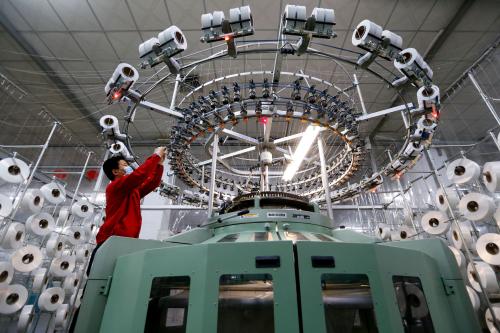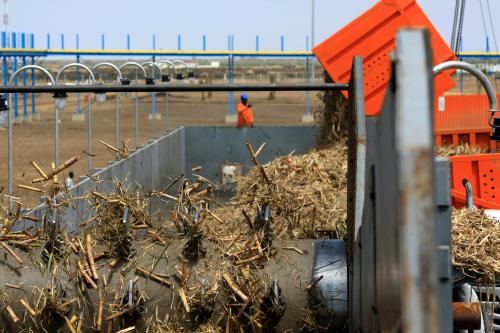This op-ed was originally published by Project Syndicate.
Recent projections indicate that several Sub-Saharan African countries will experience robust economic growth over the next five years. By 2023, around one-third of the region’s economies will have grown at an average annual rate of 5 percent or higher since 2000.
And yet, as The Economist observed last year, Africa’s development model “puzzles economists.” After all, only four of the continent’s high-growth countries are natural-resource dependent. Nor is overall performance due primarily to industrialization, as traditional development models would have predicted. What, then, explains the strong economic performance?
New research by the Brookings Institution’s Africa Growth Initiative and the United Nations University World Institute for Development Economics Research (UNU-WIDER) might hold the key to answering that question. According to the forthcoming book Industries Without Smokestacks: Industrialization in Africa Reconsidered, there is evidence to suggest that Sub-Saharan Africa is undergoing a more profound structural transformation than we think.
Africa owes this structural transformation not to traditional industries, but to new developments in tradable services and agro-industries that resemble traditional industrialization. Aside from horticulture and agro-business, these new industries include information and communication technology-based services (ICT) and tourism.
This is a departure from the historical norm. Traditionally, as Harvard University economist Dani Rodrik points out, economies that have sustained robust growth rates without relying on natural-resource booms, “typically do so through export-oriented industrialization.” But in Africa, manufacturing as a share of total economic activity has stagnated at around 10 percent, with economic activity moving from agriculture to services. And because the rate of productivity growth in services is only about half that of manufacturing, the aggregate productivity gains needed for sustained growth have fallen relatively short.
This process of premature deindustrialization is not unique to Africa. But it is more consequential for the continent, given the scale of its development challenges. Owing to its young, rapidly growing labor force, Africa now needs to create more than 11 million jobs in the formal economy every year. But as Nobel laureate economist Joseph E. Stiglitz has warned, Africa cannot replicate East Asia’s manufacturing-led model, so the question is whether it can leverage modern services to achieve economic development.
According to Foresight Africa: Top Priorities for 2018, a Brookings Institution report previewing the results of Industries Without Smokestacks, services exports from Africa grew more than six times faster than merchandise exports between 1998 and 2015. In Kenya, Rwanda, Senegal, and South Africa, the ICT sector is flourishing. In Rwanda, tourism is now the single largest export activity, accounting for about 30 percent of total exports. Ethiopia, Ghana, Kenya, and Senegal are all integrated into global horticultural value chains, and Ethiopia has become a leading player in global flower exports.
As these smokestack-less industries have grown, they have generated new patterns of structural change that are distinct from those of East Asia’s manufacturing-led transformation. But, if properly stewarded, they could play the same role in Africa’s development as manufacturing did in East Asia.
Manufacturing-led growth proved to be an effective development model in East Asia for three main reasons. First, manufacturing has higher productivity than agriculture, and it can absorb a large number of moderately skilled workers migrating out of the agriculture sector. Second, manufacturers benefit from technological transfers from abroad, so their productivity rises in line with global trends. And third, the shift to manufacturing in East Asia was oriented toward exports, which allowed production to be scaled up.
According to John Page, one of the editors of Industries Without Smokestacks, Africa’s growing service sectors share these same characteristics. In addition to being tradable, they have higher productivity and can absorb large numbers of moderately skilled workers. And like manufacturing, they also benefit from technological change and economies of scale and agglomeration.
Moreover, Africa’s smokestack-less service sectors have the added advantage of being less vulnerable to automation. Notwithstanding automation’s many benefits, it presents challenges for countries where the overriding priority is to create a sufficient number of formal-sector jobs.
While economists have been increasingly confident that Africa’s development model will be different from that of East Asia, they have been less certain about what shape it will take. An industries-without-smokestacks model offers one possible answer.
From a policy perspective, African leaders should explore more ways to support these industries’ growth, either through targeted reforms or by incorporating them into national industrialization strategies and broader development agendas. The development of industries without smokestacks can occur alongside efforts to develop those with smokestacks, thus offering a multifaceted approach for Africa to achieve structural transformation.
The Brookings Institution is committed to quality, independence, and impact.
We are supported by a diverse array of funders. In line with our values and policies, each Brookings publication represents the sole views of its author(s).






Commentary
Op-edAfrica’s alternative path to development
May 3, 2018